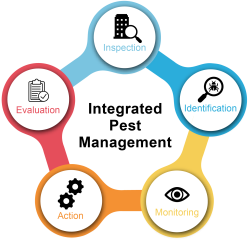Integrated Pest Management
Integrated pest management (IPM), is a strategy to continuously control weed or insect pests. This is done by utilizing cultural, biological, mechanical, and chemical methods. It is an economically and ecologically useful approach to pest management. It reduces dependence on short-term chemical applications. It also makes landscapes more resilient to invasion in the long-term.
Biological controls can be used to achieve the larger goal of helping to restore the ecology and ensuring long-term ecological health.
The goal of the Insectary is to encourage the use of self-sustaining biological controls throughout Colorado as a basis for IPM.
What is a Pest Species?
Plants or insects that are considered pests can be native or non-native species that cause economic or ecological damage. The economic impacts can include reduced forage and reduced crop yields. It can also interfere with irrigation systems or harvesting, and damage to equipment or infrastructure.
Pest species can have major ecological impacts. These can include an increase in the risk of frost damage early in the season and harboring pests. Also the impacts can include the spreading of pathogens, competing with native species for water and nutrients which can change water flows or soil structure. This may cause cascading effects in food chains.
Control Methods
IPM strategy combines multiple control methods that promote the diversity and resiliency of landscapes.
- Awareness and preventing is the best first step in an IPM strategy
- Know your pests, be able to identify invasive weeds or insects in your area
- Monitor and inspect landscapes regularly for new or changing pest issues
- Manage and contain the spread of existing pest problems
- Minimize disturbance of landscapes that may provide an opportunity for new pests
- Establishing and maintaining healthy landscapes improves resiliency to invasion
- Biological control uses the long established relationships between pest species and their natural enemies. It provides an ecological balance that keeps weeds at an acceptable level. Identifying the presence or absence of a pest species’ natural enemies can be the first step of an IPM plan.
Classical Biocontrol is the introduction of host-specific biological enemies of plant or insect pests. These enemies, or agents, are carefully selected and studied to prevent non-target effects. Once established they provide long-term suppression of introduced weed species. The Insectary’s main focus and area of study is classical biocontrol.
Augmentative biocontrol is the large release of beneficial organisms at crucial times during the growing cycle.
Conservation biocontrol is the focus on preserving and integrating native beneficial insects into cropping systems. Strategies include providing habitat for insects, minimizing life cycle disturbance and increasing biodiversity.
- Cultural controls take advantage of the natural growth cycles of weeds and insect pests to give a competitive edge to desirable species.
- Mechanical control is usually the most labor intensive control strategy. It includes hand pulling or collection, tillage, burning, mowing or any other physical removal of pest species.
- Chemical controls are important facets of a good integrated pest management strategy but their use should be carefully implemented and weighed against the ecological impacts. Improper use may have long-term consequences, such as pesticide resistance, a reduction of native and desirable species, or soil and water contamination.
